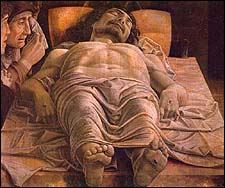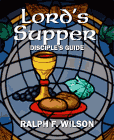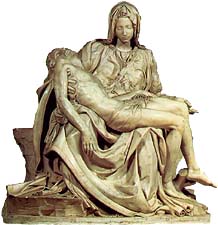
|
Old Testament
New Testament
Gospels
Acts
Paul's Letters
General Letters
Revelation
Topical Studies
Beginning the Journey (for new Christians). en Español

|
Old Testament
New Testament
Gospels
Acts
Paul's Letters
General Letters
Revelation
Topical Studies

|
Home
Bible Studies
Articles
Books
Podcasts
Search
Menu
Donate
About Us
Contact Us
FAQ
Sitemap
4. My Body Given for You (Luke 22:19b)
https://www.jesuswalk.com/lords-supper/4_body.htm
Audio (17:17)
https://www.jesuswalk.com/mp3files/lords-supper/4_body.mp3
 Andea Mantegna (Early Renaissance Italian painter, 1431-1506), The Lamentation over the Dead Christ, (c. 1490), Tempera on canvas, 68 x 81 cm Pinacoteca di Brera, Milan. Larger image. |
We considered the Lord's Supper texts in larger scope. Now let's focus in on the significance of the bread which represents Jesus' body. Two of the four Lord's Supper texts comment on how Jesus' body is sacrificed for the disciples:
|
Luke 22:19b |
1 Corinthians 11:24b |
|
This is my body |
This is my body |
|
given for you |
which is for you |
|
do this in remembrance of me. |
do this in remembrance of me. |
First, though, let's clear up a couple of textual matters. Luke 22:19b-20 is omitted in a few texts, but most ancient Greek manuscripts and modern translations retain those verses.1
My Body which Is Broken for You (1 Corinthians 11:24b, KJV)
A more noticeable correction in the text is the omission of the word "broken" in 1 Corinthians 24b, which was included in the KJV, but probably wasn't present in the earliest Greek manuscripts.2 Since I grew up on an order of service based on the KJV, it's taken me a while to get used to saying the Words of Institution without the word "broken." But I'm convinced that it's closer to Jesus' original words.3 And the meaning hasn't changed; it still focuses on sacrifice.
John 19:36 makes the point that even though the legs of those crucified on either side of Jesus were broken in order to hasten their death, Jesus was already dead so his legs were not broken: "These things happened so that the scripture would be fulfilled: 'Not one of his bones will be broken'" (citing Psalm 34:20).
The bread in the sacrament is broken, but that is not the center of our remembrance. It is not the breaking of Jesus' body but the giving of it that we are to focus on.
Jesus' Body Given for You (Luke 22:19b)
As mentioned in chapter 1, the key verb regarding the bread and body is "given," didōmi, used in Luke 22:19b with the meaning, "to dedicate oneself for some purpose or cause, give up, sacrifice."4 The word "given" is not present but clearly implied in 1 Corinthians 11:24b, since in both accounts are followed by the preposition huper, "in behalf of," which make clear that this is a reference to Jesus' voluntary sacrifice of his body for our atonement.
As we seek to meditate on Christ's body given for us, let's look at this from different angles -- his body, his giving of himself, and the voluntary nature of this sacrifice.
Jesus' Body as a Sacrifice
The most common Greek noun for "body" is sōma, "body of a human being or animal."5 In our text the word is used literally, but occasionally Paul uses the word figuratively of the church as his body, in the same way as we refer to a group of people as a "corporation" (from Latin corpus, body). Here, though, the meaning is literal.
Several New Testament passages underscore Jesus' body as a sacrifice for sin. Perhaps the most significant is from the Apostle Peter, who said,
"He himself bore our sins in his body (sōma) on the tree, so that we might die to sins and live for righteousness; by his wounds you have been healed." (1 Peter 2:24).
This verse and those that precede it are filled with strong similarities of the great passage of the Suffering Servant in Isaiah 53:
"But he was pierced for our transgressions,
he was crushed for our iniquities;
the punishment that brought us peace was upon him,
and by his wounds we are healed.
We all, like sheep, have gone astray,
each of us has turned to his own way;
and the LORD has laid on him
the iniquity of us all." (Isaiah 53:5-6)
In his human body, Jesus bore both our sins and the punishment due us for those sins.
|
Q1. (1 Peter 2:24) Why do you think the Apostle Peter emphasized Jesus' physical body, when he talks about sin-bearing?
|
Several other passages talk about the sacrifice of Christ's body:
"So, my brothers, you also died to the law through the body (sōma) of Christ, that you might belong to another, to him who was raised from the dead, in order that we might bear fruit to God." (Romans 7:4)
"And by that will, we have been made holy through (dia) the sacrifice (phosphora) of the body (sōma) of Jesus Christ once for all." (Hebrews 10:10)
In a profound passage citing Psalm 40:6-8 (reflecting the Greek Septuagint translation), the writer of Hebrews sees the body of Christ as significant, prepared to be the ultimate -- and willing -- sacrifice.
"Therefore, when Christ came into the world, he said:
'Sacrifice and offering you did not desire,
but a body (sōma) you prepared for me;
with burnt offerings and sin offerings
you were not pleased.
Then I said, "Here I am -- it is written about me in the scroll--
I have come to do your will, O God."'" (Hebrews 10:5-7)
The body can also be referred to by the word sarx, usually translated "flesh" in the New Testament. However, one of its meanings is "body, physical body."6 In the passages that follow, the NIV translate sarx appropriately as "body," while NRSV and KJV render it as "flesh."
"For Christ died for sins once for all, the righteous for the unrighteous, to bring you to God. He was put to death in the body (sarx), but made alive by the Spirit." (1 Peter 3:18)
"Therefore, since Christ suffered in his body (sarx), arm yourselves also with the same attitude, because he who has suffered in his body is done with sin." (1 Peter 4:1)
"Therefore, brothers, since we have confidence to enter the Most Holy Place by the blood of Jesus, by a new and living way opened for us through the curtain, that is, his body (sarx) ...." (Hebrews 10:19-20)
One final passage demonstrates the importance to the Christian faith that Jesus' physical, bodily suffering was actual, not symbolic. An early strand of what became Docetism emphasized a strong dualism: flesh/body was inherently evil; spirit was inherently good. Therefore, the Docetists taught that Jesus only appeared to suffer in the flesh, but since he was a spirit being, his suffering wasn't real. The Apostle John identifies this heresy clearly:
"This is how you can recognize the Spirit of God: Every spirit that acknowledges that Jesus Christ has come in the flesh (sarx) is from God, but every spirit that does not acknowledge Jesus is not from God. This is the spirit of the antichrist, which you have heard is coming and even now is already in the world." (1 John 4:2-3)
|
Q2. (1 John 4:2-3) Why does Christianity insist on a physical birth, physical suffering, and a resurrection of the physical body? How would our faith be different if Christ hadn't fully entered the human condition?
|
Paintings of Christ's Body -- Pietà and Lamentation
Roman Catholics have a long tradition of contemplating the dead body of Jesus in order to understand at a deeper level Christ's sacrifice, what he suffered for us. Paintings from this tradition are not designed to make us feel comfortable, but rather painfully aware of Christ's giving his body in death as a sacrifice on our behalf.
|
|
The most famous of the Pietà genre is Michaelangelo's "Pietà" (1499), a massive but delicate and sensitive sculpture showing St. Mary cradling the dead body of her Son before his burial. It is an almost luminous white marble, and resides in St. Peter's Basilica in the Vatican. Ponder it as you meditate on the body of Jesus given for you. (www.jesuswalk.com/lords-supper/images/michelangelo-pieta621x642.jpg)
Another "Pietà" (1471-1474) is by Giovanni Bellini, also in the Vatican. It is an amazingly detailed painting of Jesus' dead body, propped in a sitting position, surrounded by Jesus' burial party -- Joseph of Arimathea, Nicodemus, and Mary Magdalene. Look at the fascinating interplay of hands that conveys a sense of deep grief. (www.joyfulheart.com/easter/images/bellini_pieta309x400.jpg)
A third Pietà on which to meditate is Lucas Cranach the Elder's "The Trinity" (early 16th century). Observe the haunted pain in the Father's eyes as he holds the body of our crucified Savior. Our salvation is indeed costly to the Godhead. (www.jesuswalk.com/lords-supper/images/cranach_the_trinity415x600.jpg)
A second genre centers around the deposition of the body of Christ in the tomb. Andea Mantegna's, "Lamentation over the Dead Christ" (c. 1490), shown at the beginning of this chapter, is disturbing. It views Christ's unclothed body as it lies on the tomb slab, viewed from his feet, the body skillfully foreshortened by the artist. (www.jesuswalk.com/lords-supper/images/mantegna_deadchrist576x480.jpg)
 Hans Holbein the Younger, "The Body of the Dead Christ in the Tomb" (1521), Oil on wood, 30,5 x 200 cm, Kunstmuseum, Öffentliche Kunstsammlung, Basle. Larger image. |
Finally, I am struck by Hans Holbein the Younger's "Body of the Dead Christ in the Tomb" (1521). It is a ghastly, realistic painting of Christ's body lying on its back on the tomb slab, unclothed, with blackened hands. My God, what have you done for us? (www.jesuswalk.com/lords-supper/images/holbein_body1000x157.jpg)
Jesus Gave Himself to Rescue and Ransom Us
We've explored the aspect of Christ's body. Now let's look at his giving of himself.
"This is my body given for you" (Luke 22:19b).
There are several verses in the New Testament that use the verb didōmi, "give," with the preposition huper, "in behalf of."
"This bread is my flesh, which I will give for the life of the world." (John 6:51b)"For there is one God and one mediator between God and men, the man Christ Jesus, who gave himself as a ransom for all men...." (1 Timothy 2:5-6)
"... the Lord Jesus Christ, who gave himself for our sins to rescue us from the present evil age, according to the will of our God and Father." (Galatians 1:3-4)
"... Jesus Christ, who gave himself for us to redeem us from all wickedness and to purify for himself a people that are his very own, eager to do what is good." (Titus 2:13-14)
"The Son of Man did not come to be served, but to serve, and to give his life as a ransom for (anti7) many." (Matthew 20:28 = Mark 10:45)
"Christ loved us and gave himself up (paradidōmi) for (huper) us as a fragrant offering and sacrifice to God." (Ephesians 5:2)
Paradidōmi
is used here with the meaning, "hand over, turn over, give up a person," as a technical term of police and courts, "hand over into the custody of."8 Christ "turned himself in" for us, "the Righteous for the unrighteous, that he might bring us to God" (1 Peter 3:18, RSV).|
Q3. Look at the verses above which include both the word "give" and a preposition that means
"in behalf of." According to these verses, what was the purpose of Jesus giving himself in sacrifice?
|
He Voluntarily Lay Down His Life to Defend Us
This voluntary element of the Lord's Supper words is valuable for us to ponder as well. "This is my body given for you" (Luke 22:19b).
The Garden of Gethsemane was an instance where the mystery of Jesus' human and divine nature is peeled back for a moment to reveal his voluntary submission. He agonizes in prayer:
"'Father, if you are willing, take this cup from me; yet not my will, but yours be done.' An angel from heaven appeared to him and strengthened him. And being in anguish, he prayed more earnestly, and his sweat was like drops of blood falling to the ground." (Luke 22:42-44)
His holy nature recoils from bearing sin. His physical body is profused with sweat as he struggles in prayer, great drops of it falling from his body like blood.9 Later, when the soldiers appear to arrest him, Peter begins to defend with a sword, succeeding in cutting of an ear of the high priest's servant Malchus. But after having surrendered to the Father's will in Gethsemane, Jesus is resolute. He commands Peter, "Put your sword away! Shall I not drink the cup the Father has given me?" (John 18:11) "Do you think I cannot call on my Father, and he will at once put at my disposal more than twelve legions of angels?" (Matthew 26:53). Jesus wasn't arrested violently. He voluntarily allowed the soldiers to take him into custody. "This is my body given for you" (Luke 22:19b).
Tithēmi
is a very common Greek word that means "to put or place in a particular location, lay, put."10 It is used in a similar phrase with the preposition huper, "in behalf of," that represents the voluntary nature of giving his body, "to lay down his life.""I am the good shepherd. The good shepherd lays down his life for (huper) the sheep." (John 10:11, 14-15, 17)
"Greater love has no one than this, that he lay down his life for (huper) his friends." (John 15:13)
|
Q4. How does Jesus' voluntarily laying down his life for you encourage you?
How does it speak to your value and worth as a person? What does it inspire you to do?
|
 Available as e-book and paperback. |
When we remember Jesus' body given for us, it is meant to form us as both recipients of his grace and dispensers of that grace. "Do this in remembrance of me," Jesus said.
Prayer
Father, reproduce in us your own heart, I pray. Stretch us as we remember Jesus' giving his body in sacrifice. Work in us that same spirit of unconditional love and committed sacrifice, that we might represent you well on this earth. In Jesus' name, we pray. Amen.
References
Common Abbreviations www.jesuswalk.com/lords-supper/refs.htm
- The KJV and most modern translations (NIV, RSV later edition, NRSV, NASB, NJB) include the longer text with the overwhelming external evidence. The "Western Text" (D ita,d,ff2,i,l) omit verses 19b and 20. The longer text is included in the United Bible Societies Greek New Testament (third edition) with a {C} confidence rating (Bruce M. Metzger, A Textual Commentary on the Greek New Testament (United Bible Societies, 1971), p. 173-177).
- Most modern translations include the phrase, "which is for you," omitting the word "broken." This reading is found in the Third Edition of the UBS Greek text {B}, confidence rating, and in most of the earliest texts: p46 Aleph* A B C* 6 33 424c 1739* arm Origen Cyprian. The KJV includes the word "broken," with Alephc C3 Db,c G K P Ψ 81 614 1739mg Byz Lect itd,g syrp,h goth, apparently derived from 'broke' in the previous clause. Other ancient texts are: "which is broken in pieces for you," in Dgr*, and "which is given for you," in vg copsa,bo eth Euthalius, it61, assimilated to Luke 22:19 "The concise expression ('which is for you') is characteristic of Paul's style," says Metzger (A Textual Commentary, p. 562).
- For more information, see
"Introduction to Textual Criticism," in the appendix
(www.joyfulheart.com/scholar/textcrit.htm).
- Didōmi
, BDAG 242, 10. - Sōma , BDAG 983-984, 1.a.
- Sarx , BDAG 914-916, 2.a.
- The preposition anti carries the meaning "1. instead of, in place of," here 3. indicating a process of intervention, "in behalf of, for someone, so that anti becomes = huper" (BDAG 87-88).
- Paradidōmi , BDAG 1.b.
- Some have interpreted this as sweat mixed with blood caused by broken capillaries brought on by stress, but I think the simplest interpretation is to see the relationship between sweat and blood in the drops falling.
- Tithēmi , BDAG 1003-1004.
Copyright © 2026, Ralph F. Wilson. <pastor![]() joyfulheart.com> All rights reserved. A single copy of this article is free. Do not put this on a website. See legal, copyright, and reprint information.
joyfulheart.com> All rights reserved. A single copy of this article is free. Do not put this on a website. See legal, copyright, and reprint information.



 To be notified about future articles, stories, and Bible studies, why don't you subscribe to our free newsletter, The Joyful Heart, by placing your e-mail address in the box below. We respect your
To be notified about future articles, stories, and Bible studies, why don't you subscribe to our free newsletter, The Joyful Heart, by placing your e-mail address in the box below. We respect your